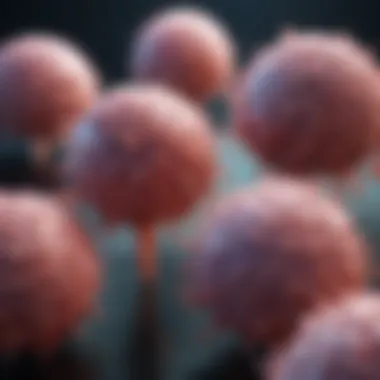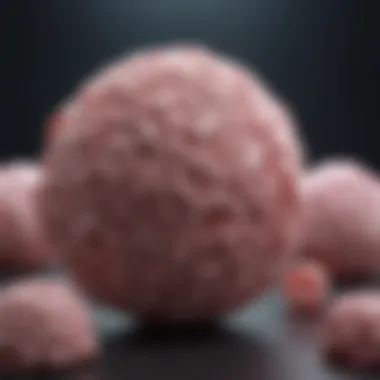BRAF Mutation Assay: Critical Insights for Oncology


Intro
The study of BRAF mutations presents a significant dimension in cancer research, specifically within the context of malignant melanoma. These mutations, primarily BRAF V600E, are crucial for both diagnosis and targeted treatment strategies. Their influence on tumorigenesis continues to be a focal point for researchers aiming to elucidate cancer mechanisms and improve patient outcomes.
That BRAF mutation assay plays a vital role in identifying these genetic alterations cannot be overstated. Knowledge of the mutational status informs therapeutic decisions, allowing for more personalized treatment approaches. In this examination, we will unravel the relation between BRAF mutations and oncological care, emphasizing how mutation assays shape the landscape of cancer therapy.
Research Overview
Summary of Key Findings
BRAF mutations are present in approximately 40-60% of malignant melanomas. Research highlights their pivotal role in downstream signaling pathways that promote cell proliferation and survival. The ability to detect these mutations through methodological assays has transformed clinical practices, enabling oncologists to tailor treatment regimens for patients based on genetic profiles.
The advent of targeted therapies, such as vemurafenib and dabrafenib, has marked a significant advancement in melanoma management. These drugs specifically inhibit the aberrant BRAF protein, demonstrating marked improvement in patient survival rates. The mutation's role extends beyond melanoma; it is also identified in various other cancers, such as colorectal and thyroid cancers. Thus, the importance of the BRAF mutation assay cannot be underestimated.
Background and Context
The BRAF gene, located on chromosome 7, encodes a protein that is part of the MAPK signaling pathway, which is essential for cell division. Mutations within this gene lead to unregulated cell growth and contribute to the oncogenic process. The most common mutation, BRAF V600E, accounts for a large percentage of BRAF-related malignancies. Understanding the context of BRAF mutations requires an appreciation for the biochemical cascade that these mutations influence, including the cellular response to growth factors and the overall tumor microenvironment.
Methodology
Experimental Design
The BRAF mutation assay employs various methodologies, including polymerase chain reaction (PCR) and next-generation sequencing (NGS). PCR amplifies specific DNA sequences for easier detection, while NGS allows for comprehensive analysis of multiple mutations simultaneously, providing more extensive genetic information.
Data Collection Techniques
Sample acquisition typically involves tumor biopsies or liquid biopsy for less invasive patient management. Following sample collection, the extraction of DNA is performed, preparing it for analysis through sequencing techniques. This process requires meticulous care to ensure data integrity, as the accuracy of mutation detection is paramount in guiding treatment decisions.
The evolution of BRAF mutation assays underscores their critical role in modern oncology. As research progresses, enhanced testing methodologies promise improved precision in cancer diagnostics.
Preamble to BRAF Mutations
The exploration of BRAF mutations is critical within the context of cancer diagnostics and treatment. BRAF is a gene that encodes a protein involved in the regulation of cell growth. When mutations occur, they can lead to uncontrolled cell division. This underlines the significance of understanding BRAF mutations, particularly in relation to melanoma and other cancers.
BRAF mutations serve not only as biomarkers for diagnosing certain cancer types but also play a pivotal role in determining treatment strategies. An insight into their clinical implications allows healthcare professionals to tailor therapies that target specific mutations. This customization enhances patient outcomes and optimizes the efficacy of cancer treatments, driving the necessity of BRAF mutation assays in clinical practice.
In this section, two key elements regarding BRAF mutations will be discussed: what they are and their clinical significance. Both factors establish a foundation for a deeper understanding of the methodologies and therapeutic approaches examined later in this article.
Biochemistry of BRAF
The biochemistry of BRAF is crucial in understanding its role in oncogenesis and therapeutic targeting. BRAF is a proto-oncogene that encodes a protein involved in the MAPK/ERK signaling pathway. This pathway plays a significant part in regulating cellular processes, including proliferation, differentiation, and survival. When mutations occur in the BRAF gene, they can lead to dysregulation of this signaling pathway, which contributes to cancer development.
Function of BRAF Protein
The BRAF protein kinase is a key regulator in the RAS-RAF-MEK-ERK signaling cascade. In normal conditions, BRAF interacts with RAS proteins and activates downstream components like MEK and ERK. This activation promotes normal cellular functions such as growth and division.
Presence of BRAF mutations, particularly the V600E variant, results in continuous activation of the MAPK pathway, leading to unchecked cell proliferation. Understanding the biological function of BRAF allows researchers to develop targeted therapies. This connection illustrates why BRAF is a focal point in cancer therapy and genetic testing.
Consequences of Mutations
The consequences of mutations in the BRAF gene are profound. The most studied mutation is the V600E, which causes the BRAF protein to be constitutively active. As a result, cells lose the control of growth and division. This uncontrolled proliferation is a hallmark of many cancers, especially melanoma.
Consequently, patients with BRAF mutations may have a poorer prognosis and response to standard therapies. Therefore, identifying these mutations through BRAF mutation assays is essential. It helps guide clinicians in selecting appropriate treatments, such as BRAF inhibitors. Moreover, not all BRAF mutations carry the same implications. Some may respond well to specific therapies, while others may not, affecting overall treatment strategies.


The identification of BRAF mutations enhances understanding of tumor biology, informing precision medicine approaches.
In summary, the biochemistry of BRAF is elaborative in unraveling both fundamental cellular processes and its contributions to the pathogenesis of cancer. Therefore, studying BRAF mutations is pivotal for advancing cancer diagnostics and developing more effective therapies. Understanding the biological and pathological implications of these mutations can provide insight into improving patient outcomes.
Understanding BRAF Mutation Assays
In the realm of oncology, BRAF mutation assays emerge as critical tools. They aid in identifying genetic alterations that can influence treatment decisions and patient outcomes. Understanding the different types of mutation assays and their methodologies is essential for effectively leveraging this information in clinical practice. This section brings clarity to the types of assays available, how they operate, and the importance of proper sample handling, forming a foundation for future discussions on BRAF mutations in cancer treatment.
Types of BRAF Mutation Assays
Numerous types of BRAF mutation assays exist. Each method offers distinctive advantages and limitations. Here, we will explore three predominant assays utilized in clinical settings: Polymerase Chain Reaction (PCR), Sanger Sequencing, and Next-Generation Sequencing (NGS).
Polymerase Chain Reaction (PCR)
Polymerase Chain Reaction, commonly known as PCR, has a significant role in amplifying DNA sequences. The basic function of this technique is to make millions of copies of a specific DNA segment. This amplification is crucial for detecting low-abundance mutations in clinical samples. A key characteristic of PCR is its sensitivity. It can detect even small percentages of mutated DNA among normal sequences.
The unique aspect of PCR is its rapid nature and ease of use, making it a favored choice in many laboratories. Despite its advantages, PCR has limitations. It mainly focuses on specific mutations predetermined by the assay design, potentially overlooking other mutations. This specificity could prove disadvantageous, requiring supplementary techniques to ensure comprehensive testing.
Sanger Sequencing
Sanger Sequencing is a foundational method for DNA sequencing. It serves to confirm specific mutations detected by PCR. The technique relies on incorporating chain-terminating inhibitors during DNA replication. A pivotal characteristic of Sanger Sequencing is its accuracy. This method provides reliable sequencing of individual mutations. Hence, it is routinely used in clinical validation of mutations.
One notable feature of Sanger Sequencing is its resolution of mutations in a relatively cost-effective way for low-throughput samples. However, its limitations include a slow processing time when compared to newer technologies. It may also become inefficient when analyzing samples with many mutations since it is not designed for high-throughput applications.
Next-Generation Sequencing (NGS)
Next-Generation Sequencing represents a technological advancement in the field of genomics. NGS enables parallel sequencing of numerous DNA fragments, providing a comprehensive view of mutations within a specific gene. A primary advantage of NGS is its high throughput, allowing for extensive profiling of multiple mutations within a single assay.
The unique feature of NGS lies in its ability to provide both qualitative and quantitative data on mutations. This comprehensive insight is crucial in a clinical setting where personalized medicine thrives. However, NGS comes with challenges including higher costs and a greater need for bioinformatics support, which can complicate interpretation of results compared to traditional methods.
Sample Collection and Handling
Proper sample collection and handling are critical for any BRAF mutation assay. The integrity of biological materials can drastically influence the outcomes of these tests. Precise guidelines must be followed to minimize contamination and degradation. Samples must be processed quickly, and conditions for storage should be strictly controlled to maintain viability.
In summary, understanding BRAF mutation assays and their methodologies is essential. Each assay type has its strengths and weaknesses. The choice of assay may depend on specific clinical scenarios and the information required. Therefore, using the appropriate methodology in conjunction with careful sample handling can enhance the accuracy and relevance of testing outcomes. This understanding lays the groundwork for further exploration of BRAF mutations in cancer.
Methodologies in BRAF Mutation Testing
The methodologies utilized in BRAF mutation testing are pivotal in the field of cancer diagnostics. These techniques enable accurate identification of BRAF mutations, which are linked to various malignancies, most notably melanoma. Understanding the methodologies is essential for clinicians and researchers as they influence both the diagnostic process and subsequent treatment decisions.
PCR Techniques in Detail
Polymerase Chain Reaction (PCR) stands as one of the most widely used methods in molecular biology for amplifying specific DNA sequences. In BRAF mutation testing, PCR serves a fundamental role. It allows for the selective amplification of regions of the BRAF gene where mutations are most likely to occur.
Here are key elements regarding PCR techniques for BRAF testing:
- Specificity: PCR can be finely tuned to target specific mutations, reducing the risk of false positives. By employing specific primers that bind to mutated sequences, the likelihood of detecting the actual mutation increases.
- Sensitivity: PCR is highly sensitive and can detect low frequencies of mutations. This is particularly crucial for patients with heterogenous tumors where mutant alleles may exist at low levels compared to wild-type.
- Rapid results: One of the advantages of PCR is the relatively quick turnaround time. Clinicians can obtain results within a few hours, which aids in expediting treatment plans.
However, PCR is not without its limitations. Contamination is a significant concern, as it can lead to erroneous results. Furthermore, certain mutations in the BRAF gene may be missed if the PCR is not properly designed to cover those regions.
Interpreting Sequencing Data
Sequencing data from BRAF mutation assays must be carefully interpreted to inform clinical decisions. The two most common methods—Sanger sequencing and next-generation sequencing (NGS)—generate extensive data on the genetic makeup of the BRAF gene. Interpreting this data requires both technical expertise and clear guidelines, as errors in interpretation can lead to misdiagnosis and ineffective treatment strategies.
When analyzing sequencing data, the following aspects are important:


- Mutation Calling: Analysts must distinguish between true mutations and benign polymorphisms. This requires an in-depth understanding of the BRAF mutation spectrum.
- Clinical Relevance: Not all mutations have the same implications for treatment. Some may be actionable, meaning specific therapies can be employed, while others may not significantly impact patient management. This necessitates a nuanced approach when interpreting results.
- Allele Frequency: Understanding the variant's frequency is critical. The presence of a mutation at a low allele frequency may suggest clonal evolution within the tumor, potentially influencing prognosis and therapeutic decisions.
In practice, correlating sequencing data with clinical outcomes enhances the overall understanding of how specific mutations affect cancer progression and response to therapies.
"Accurate interpretation of sequencing data not only aids in diagnosis but also guides personalized treatment in patients with BRAF mutations."
Implications of BRAF Mutations in Cancer
The implications of BRAF mutations in cancer diagnosis and treatment have become a focal point in oncology. Understanding these mutations goes beyond mere identification; it significantly impacts patient management and therapeutic strategies. BRAF mutations primarily affect key pathways that regulate cell growth. The most notable of these mutations is BRAF V600E, frequently observed in melanoma. Thus, identifying these mutations can lead to critical decisions regarding treatment options and prognostic evaluations.
Prognostic Marker for Melanoma
BRAF mutations serve as a vital prognostic marker in melanoma. Patients with these mutations often have distinct clinical outcomes compared to those without them. Research indicates that melanoma patients harboring BRAF mutations tend to exhibit more aggressive disease features but also respond better to targeted therapies like vemurafenib and dabrafenib.
Several studies demonstrate that the presence of BRAF mutations correlates with poorer overall survival and higher recurrence rates. By assessing these mutations, clinicians can stratify patients based on risk. A recent study showed that early detection of BRAF V600E mutations can significantly influence the therapeutic approach and improve management strategies. In clinical practice, this knowledge empowers oncologists to tailor treatment plans more effectively, thereby enhancing patient outcomes.
Role in Personalized Medicine
The role of BRAF mutations in personalized medicine is evolving. Personalized medicine aims to customize healthcare, with medical decisions tailored to the individual patient. In the context of BRAF mutations, molecular profiling enables oncologists to identify specific genetic alterations and apply targeted treatments. These treatments are designed to attack cancer cells while sparing normal tissues, minimizing side effects.
BRAF inhibitors have revolutionized treatment pathways for patients with melanoma. For many patients, these therapies have provided extended survival times. Furthermore, ongoing research focuses on understanding resistance mechanisms. This not only includes identifying secondary mutations but also exploring combination therapies that enhance effectiveness.
"Identifying and understanding BRAF mutations empowers oncologists to make informed decisions, ultimately influencing patient outcomes positively."
The future of cancer treatment is heavily dependent on the continual research surrounding BRAF mutations, making it essential for both present applications and future developments in oncology.
Therapeutic Strategies Targeting BRAF Mutations
The strategic targeting of BRAF mutations has become a pivotal area in cancer treatment, especially in the context of malignant melanoma and other BRAF mutation-positive tumors. Understanding these therapeutic methods is essential due to their profound impact on patient outcomes and overall prognosis. BRAF mutations, particularly the common V600E variant, lead to uncontrolled cellular proliferation. Therefore, therapies targeting these mutations aim to disrupt this aberrant signaling pathway, offering better management of disease progression.
BRAF Inhibitors
BRAF inhibitors play a crucial role in targeted therapy. Medications such as Vemurafenib and Dabrafenib specifically inhibit the mutated BRAF protein, aiming to restore normal cell signaling and limit tumor growth. These inhibitors have shown significant effectiveness in reducing tumor burden and can lead to improved survival rates in patients with advanced melanoma.
Mechanism of Action
BRAF inhibitors bind to the mutated protein, blocking its activity. This results in the inhibition of downstream signaling pathways that promote cell division. The clinical use of these drugs has transformed the treatment landscape for BRAF mutation-positive melanoma, enabling clinicians to provide more tailored and effective treatments.
However, it is important to be aware of potential resistance mechanisms that might develop from continuous pharmaceutical targeting. This resistance can diminish treatment efficacy over time, making combination strategies critical.
"BRAF inhibitors have changed the course of treatment for many patients, but vigilance against resistance is crucial."
Combination Therapies
Combination therapies are increasingly recognized as a necessary approach in managing BRAF mutation-positive cancers. These strategies often involve using BRAF inhibitors alongside MEK inhibitors like Trametinib. This dual approach targets two different points within the MAPK pathway, which may offer enhanced effectiveness compared to single-agent therapies. The rationale behind this approach lies in the understanding that although BRAF inhibitors can initially control tumor growth, they are frequently met with resistance.
Benefits of Combination Therapies
- Reduced Resistance: By targeting multiple pathways, combination therapies can help mitigate the risk of resistance associated with monotherapy.
- Improved Efficacy: Patients often experience better clinical outcomes due to the synergistic effects of the combined agents.
- Broader Application: This strategy allows for a more comprehensive attack on tumors, potentially managing various stages of BRAF mutation-positive cancers.
As research continues, the exploration of these therapeutic strategies remains crucial. It's vital to adapt treatment plans based on the latest evidence, emphasizing both the individual mutation profile and the evolving nature of cancer therapy.
Limitations of Current BRAF Mutation Assays


The identification of BRAF mutations through assays is crucial in the context of oncology. However, understanding the limitations of these assays is equally essential in making informed clinical decisions. These limitations can impact diagnosis and treatment approaches significantly. Recognizing false results and financial constraints is vital for improving patient outcomes.
False Positives and Negatives
Assays for BRAF mutations, while generally reliable, are not infallible. False positives represent cases where mutations are incorrectly identified. This may lead to unnecessary treatments that can have adverse consequences for the patients. On the other hand, false negatives occur when a mutation present in the sample is not detected. Such oversights can result in missed opportunities for targeted therapies, leaving patients on less effective treatment regimens.
The sources of these inaccuracies can vary:
- Technical errors during sample processing
- Reagent quality and reliability of assay methods
- Biological variability among different tumors
Regular validation and optimization of testing methods can help mitigate these risks. Ongoing education for technicians and researchers about the nuances of error potential is crucial.
"Detection effectiveness is key. Regularly reassessing techniques can cut down on both false positives and negatives."
Cost and Accessibility Issues
Another major factor is the cost and accessibility of BRAF mutation assays. While the technologies exist to perform these tests, they can often be expensive. The availability of resources can vary drastically across different regions and healthcare systems, which may lead to unequal access to testing.
Some important considerations include:
- Cost of testing: Advanced techniques like Next-Generation Sequencing often result in higher expenses, placing them out of reach for some institutions or patients.
- Insurance coverage: Not all insurance plans provide coverage for comprehensive genetic testing, which contributes to disparities in access.
- Geographical variations: Patients in remote areas may face additional hurdles, as specialized laboratories might not be readily available.
These factors can lead to delays in diagnosis and treatment. It is important for stakeholders in healthcare to address these challenges and foster a more equitable approach to BRAF mutation testing.
Future Directions in BRAF Mutation Research
The study of BRAF mutations is an evolving field, vital for advancing oncology diagnostics and therapies. As research progresses, the need to explore innovative methodologies becomes paramount. The future of BRAF mutation research not only aims to refine current techniques but also aspires to uncover new therapeutic avenues. Understanding the implications of emerging technologies and potential treatment developments is essential because they promise to enhance patient outcomes and offer more tailored approaches in cancer management.
Emerging Technologies
New technologies continually reshape the landscape of BRAF mutation research. Enhanced techniques can improve the sensitivity and specificity of mutation detection. The integration of artificial intelligence into genetic testing presents an exciting frontier. AI algorithms can analyze sequencing data more rapidly than traditional methods. This efficiency can lead to quicker clinical decisions, which is crucial in oncology. Additionally, advances in liquid biopsy techniques allow for non-invasive sampling of tumor DNA, offering a dynamic understanding of tumor evolution over time.
Next-generation sequencing methods continue to expand in capability. They facilitate comprehensive genomic profiling, uncovering not just BRAF mutations, but also co-occurring mutations that may affect treatment choices. These advancements underscore the necessity to stay abreast of technological shifts and adapt testing methodologies accordingly.
Potential Developments in Treatment
Therapeutic strategies targeting BRAF mutations are expanding beyond the current inhibitors. While BRAF inhibitors like Vemurafenib and Dabrafenib have shown efficacy, resistance mechanisms often develop. Research into combination therapies is promising. For example, integrating BRAF inhibitors with MEK inhibitors has demonstrated enhanced effectiveness by addressing pathways that contribute to resistance. The exploration of immune checkpoint inhibitors in conjunction with BRAF-targeted therapies is another area of active investigation.
Moreover, personalized medicine continues to gain prominence. The future of treatment may involve tailoring therapies based on the individual mutation profile of tumors. Assessing secondary mutations and their impact on treatment response will allow for more precise and effective interventions. This evolving landscape indicates that future developments will likely result in a multidimensional approach to treating cancers associated with BRAF mutations.
"The future of BRAF mutation research is not just about identifying mutations but about understanding their role in the broader context of cancer biology."
In summary, the future directions in BRAF mutation research encompass technological advancements and innovative treatment developments. The ongoing exploration in these areas will significantly enhance the understanding and management of cancers, highlighting the importance of continual investment in research and development.
The End
The conclusion of this article is essential in encapsulating the critical findings related to BRAF mutation assays and their influence within oncology. This section summarizes the importance of understanding BRAF mutations, their implications for patient treatment, and ongoing advancements in research.
Summary of Key Points
In this article, we explored the following key points regarding BRAF mutation assays:
- Definition and Importance: BRAF mutations are pivotal in various cancers, notably melanoma, affecting patient prognosis and treatment strategies.
- Assay Methodologies: We examined several methodologies for BRAF mutation testing, such as Polymerase Chain Reaction (PCR), Sanger sequencing, and Next-Generation Sequencing (NGS). Each method has unique advantages and limitations.
- Clinical Relevance: The presence of BRAF mutations serves as a significant prognostic marker and guides personalized medicine, tailoring therapies to individual patient profiles.
- Therapeutic Implications: The use of BRAF inhibitors and potential combination therapies represent promising areas of treatment that can improve outcomes for patients with BRAF-related cancers.
- Limitations and Future Directions: Challenges remain, including issues of testing accuracy and costs. Future developments suggest paths toward more effective, accessible mutation assays.
Implications for Future Research
The implications for future research in the realm of BRAF mutation assays are multifaceted and critical for advancing cancer treatment. Several key areas for investigation include:
- Innovative Technologies: Exploring new technologies for mutation detection may improve accuracy and reduce costs. Techniques such as liquid biopsies and advanced sequencing may enhance diagnostic capabilities.
- Understanding Resistance Mechanisms: Future studies may focus on why some patients develop resistance to BRAF inhibitors, prompting the need for alternative or combination treatments.
- Long-term Outcomes: Research should emphasize the long-term effectiveness of targeted therapies and their role in improving survival rates among different patient demographics.
- Integration of Genomic Data: Larger scale studies are needed to integrate multi-omic data, allowing for a comprehensive understanding of BRAF mutations and their interactions with other genetic factors.
The ongoing investigations into BRAF mutations and their assays will continue to shape cancer treatment pathways, ultimately influencing clinical outcomes for diverse populations. By addressing the existing gaps in knowledge and developing innovative solutions, researchers can improve both diagnostic and therapeutic strategies, leading to better patient results.







